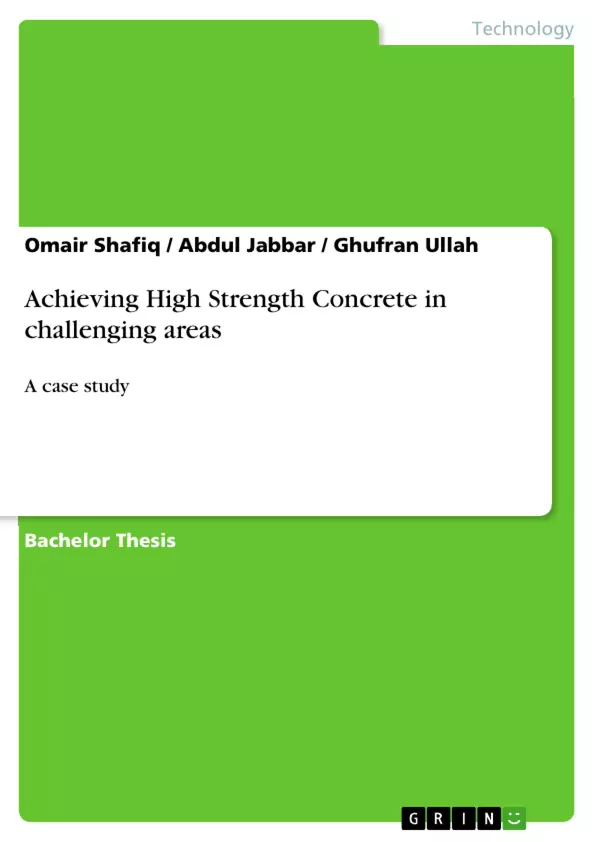This study introduces the need, difficulties associated with and solutions for implementing the use of High Strength Concrete in Peshawar and challenging areas in general. It does so by using Peshawar as a case study and generalizing its characteristics to any other such regions in the world.
It reviews current standard methods for making High Strength Concrete in the world and investigates those used in the target region. Then compares them to find the difficulties that stand as a hindrance in achieving High Strength Concrete in said area, naming them as challenges. It uses the PEC (Pakistan Engineering Council) contractors’ categorization to provide guidelines for each category to tackle the challenge that hinders it the most. Furthermore, it provides a set of actions for PEC to follow for a successful implementation of High Strength Concrete in the area. It also gives a review of the process for use in other challenging environments, also giving examples of such environments in Pakistan and other parts of the world.
Inhaltsverzeichnis (Table of Contents)
- Chapter 1. Introduction
- 1.1 The Construction Industry in Peshawar
- 1.2 Limitations of the current practices
- 1.2.1 Standard Methods of Design and Practice
- 1.2.2 Standard Process of Construction
- 1.2.3 Standard Construction Practices
- 1.2.4 What happens in Peshawar?
- 1.2.5 The Problem
- 1.3 High Strength Concrete
- 1.3.1 Education of the General Public
- 1.3.2 Using materials with higher strength
- 1.3.3 Conclusion
- 1.3.4 Further Discussion
- 1.4 Problem Statement (A Challenging Environment)
- 1.5 Peshawar As A Case Study
- 1.6 Scope and Significance
- 1.6.1 Significance
- 1.6.2 Scope
- 1.7 Approach
- Chapter 2. Literature Review
- 2.1 Concrete
- 2.1.1 Concrete
- 2.1.2 Portland cement as Hydraulic Binder
- 2.1.3 Aggregates
- 2.1.4 Cement Hydration and Concrete formation
- 2.1.5 Fresh Concrete and its transport, placement problems
- 2.1.6 Concrete Strength and Failure Mechanism
- 2.1.7 Factors affecting the strength of concrete
- 2.1.8 Reinforced Concrete
- 2.1.9 Importance
- 2.2 High Strength Concrete (363, 2010)
- 2.2.1 Definition
- 2.2.2 Materials for Production
- 2.2.3 Proportioning
- 2.2.4 Fresh HSC
- 2.3 Specifications
- 2.3.1 Cement
- 2.3.2 Course and Fine Aggregates
- 2.3.3 Silica Fume
- 2.3.4 HRWR
- 2.4 A New Method Of Mixing
- 2.4.1 Mechanism of Failure in Concrete
- 2.4.2 Delaying Bond Failure
- 2.4.3 Silica Fume
- 2.4.4 Need for Dispersion
- 2.4.5 New Method of Mixing (Lewis, 2019)
- Chapter 3. Methodology
- 3.1 Defining HSC In Peshawar
- 3.1.1 Data of Cylinder Tests
- 3.1.2 Laboratory Tests
- 3.1.3 Borderline
- 3.2 Availability of Materials
- 3.2.1 Cement
- 3.2.2 Sand
- 3.2.3 Aggregate
- 3.2.4 Silica Fume
- 3.2.5 HRWR
- 3.3 Construction Practices in Peshawar (Zada, 2019)
- 3.3.1 Two Categories
- 3.3.2 Mix Design or Proportioning
- 3.3.3 Fresh HSC
- 3.3.4 Gallery
- 3.4 Challenges
- 3.4.1 Formulation of Strength Required (318, 2011)
- 3.4.2 Aggregate Ratios
- 3.4.3 Use of SCMS and Admixtures
- 3.4.4 Quality Control and Testing
- 3.4.5 Batching Plants and SD
- 3.4.6 Industry Acceptance
- 3.5 Categorization
- 3.5.1 Categories and Solutions to Challenges for Each
- 3.6 Role of the Authorities
- 3.6.1 Stage-I
- 3.6.2 Stage-II
- Chapter 4. Conclusion
- 4.1 Expanding Horizons
- 4.2 Examples
- 4.2.1 Lahore (Space)
- 4.2.2 Gilgit (Soil)
- 4.2.3 Kashghar (Conflict)
- 4.3 Conclusion
Zielsetzung und Themenschwerpunkte (Objectives and Key Themes)
This thesis focuses on achieving high strength concrete in a challenging environment, specifically in the Peshawar region of Pakistan. The research investigates the limitations of current construction practices and examines the potential of high strength concrete to improve structural integrity and sustainability. The authors aim to present a comprehensive understanding of the challenges and opportunities associated with implementing high strength concrete in this environment, contributing to the advancement of the construction industry in Pakistan.
- Challenges of implementing high strength concrete in Peshawar
- Analysis of existing construction practices and their limitations
- Evaluation of the potential of high strength concrete to improve structural integrity
- Investigation of the role of materials and techniques in achieving high strength concrete
- Exploration of solutions and strategies to overcome challenges related to high strength concrete implementation
Zusammenfassung der Kapitel (Chapter Summaries)
Chapter 1 introduces the reader to the construction industry in Peshawar, highlighting the limitations of current practices and the potential of high strength concrete to address these shortcomings. It outlines the problem statement and scope of the research, establishing the need for a comprehensive understanding of high strength concrete in a challenging environment. Chapter 2 presents a literature review on concrete, exploring its fundamental properties, the use of Portland cement, and the factors influencing its strength. It delves into the specific requirements and characteristics of high strength concrete, emphasizing the importance of materials selection and mix design. Finally, Chapter 3 outlines the methodology adopted to define high strength concrete in Peshawar, analyzing the availability of materials and existing construction practices. This chapter concludes by identifying the key challenges associated with implementing high strength concrete in this environment.
Schlüsselwörter (Keywords)
High strength concrete, construction industry, Peshawar, Pakistan, challenging environment, materials, mix design, construction practices, structural integrity, sustainability, limitations, opportunities, solutions, strategies.
- Citation du texte
- Omair Shafiq (Auteur), Abdul Jabbar (Auteur), Ghufran Ullah (Auteur), 2019, Achieving High Strength Concrete in challenging areas, Munich, GRIN Verlag, https://www.grin.com/document/496075



